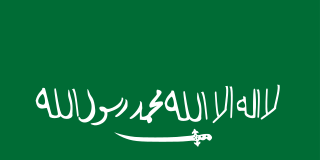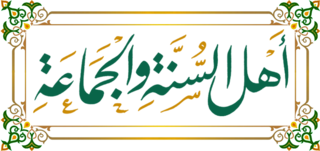Related Research Articles
Muḥammad ibn ʿAbd al-Wahhāb ibn Sulaymān al-Tamīmī (1703–1792) was a Sunni Muslim scholar, theologian, preacher, activist, religious leader, jurist, and reformer, who was from Najd in central Arabia and is considered as the eponymous founder of the Wahhabi movement. His prominent students included his sons Ḥusayn, Abdullāh, ʿAlī, and Ibrāhīm, his grandson ʿAbdur-Raḥman ibn Ḥasan, his son-in-law ʿAbdul-ʿAzīz ibn Muḥammad ibn Saʿūd, Ḥamād ibn Nāṣir ibn Muʿammar, and Ḥusayn āl-Ghannām.

Wahhabism is a religious revivalist movement within Sunni Islam named after the 18th-century Hanbali scholar Muhammad ibn 'Abd al-Wahhab. It was initially established in the central Arabian region of Najd and later spread to other parts of the Arabian Peninsula, and is today followed primarily in Saudi Arabia and Qatar.

The Salafi movement or Salafism is a revival movement within Sunni Islam, which was formed as a socio-religious movement during the late 19th century and has remained influential in the Islamic world for over a century. The name "Salafiyya" is a self-designation, to call for a return to the traditions of the "pious predecessors", the first three generations of Muslims, who are believed to exemplify the pure form of Islam. In practice, Salafis claim that they rely on the Qur'an, the Sunnah and the Ijma (consensus) of the salaf, giving these writings precedence over what they claim as "later religious interpretations". The Salafi movement aimed to achieve a renewal of Muslim life and had a major influence on many Muslim thinkers and movements across the Islamic world.

Juhayman ibn Muhammad ibn Sayf al-Otaybi was a Saudi religious dissident and ex-soldier who led the Ikhwan during their Grand Mosque seizure in 1979. He and his followers besieged and took over the Grand Mosque of Mecca on 20 November 1979 and held it for two weeks. During this time, he called for an uprising against the House of Saud and also reportedly proclaimed that the Mahdi had arrived in the form of one of the Ikhwan's leading officials; al-Otaybi's insurgency ended with Saudi authorities capturing the surviving militants and publicly executing them all, including al-Otaybi. The incident led to widespread unrest, culminating in large-scale anti-American riots throughout the Muslim world, particularly after Iranian religious cleric Ruhollah Khomeini of the Islamic Revolution falsely claimed over a radio broadcast that Juhayman's insurgency at the holiest Islamic site had been orchestrated by the United States and Israel.

Islam is the state religion of Saudi Arabia. The kingdom is called the "home of Islam"; it was the birthplace of the Islamic prophet Muhammad, who united and ruled the Arabian Peninsula. It is the location of the cities of Mecca and Medina, where Prophet Muhammad lived and died, and are now the two holiest cities of Islam. The kingdom attracts millions of Muslim Hajj pilgrims annually, and thousands of clerics and students who come from across the Muslim world to study. The official title of the King of Saudi Arabia is "Custodian of the Two Holy Mosques"—the two being Al-Masjid al-Haram in Mecca and Al-Masjid al-Nabawi in Medina—which are considered the holiest in Islam.

The Ikhwan, commonly known as Ikhwan man ata'a Allah, was a Wahhabi religious militia made up of traditionally nomadic tribesmen which formed a significant military force of the ruler Ibn Saud and played an important role in establishing him as ruler of most of the Arabian Peninsula in the unified Kingdom of Saudi Arabia.

The Committee for the Promotion of Virtue and the Prevention of Vice is a government religious authority in Saudi Arabia that is charged with implementing the Islamic doctrine of hisbah in the country. Established in 1940, the body gained extensive powers in the 1980s and continued to function as a semi-independent civilian law enforcement agency for almost 35 years until 2016, when societal reforms driven by then-deputy crown prince Mohammed bin Salman led to limiting some of its authority through a royal decree by King Salman bin Abdulaziz, including the rights of pursuing, questioning, detaining, and interrogating suspects.
Safar bin Abd al-Rahman al-Hawali al-Ghamdi is a scholar who lives in Mecca. He came to prominence in 1991, as a leader of the Sahwah movement which opposed the presence of US troops on the Arabian Peninsula. In 1993, al-Hawali and Salman al-Ouda were leaders in creating the Committee for the Defense of Legitimate Rights, a group that opposed the Saudi government, for which both were imprisoned from 1994 to 1999.
Abd al-Aziz ibn Abd Allah Al Baz, known simply as Ibn Baz or Bin Baz, was a Saudi Islamic scholar who served as the grand mufti of Saudi Arabia from 1993 until his death in 1999.

The Grand Mosque seizure was a siege that took place between 20 November and 4 December 1979 at the Grand Mosque of Mecca, the holiest Islamic site in Mecca, Saudi Arabia. The building was besieged by up to 600 militants under the leadership of Juhayman al-Otaybi, a Saudi anti-monarchy Islamist from the Otaibah tribe. They identified themselves as "al-Ikhwan", referring to the religious Arabian militia that had played a significant role in establishing the Saudi state in the early 20th century.

Tareq Mohammed Al-Suwaidan is a Kuwaiti Islamic author and speaker, and businessman. He has been among the 500 Most Influential Muslims in 2022, 2023 and 2024.

Islamic extremism, Islamist extremism or radical Islam refers to a set of extremist beliefs, behaviors and ideologies within Islam. These terms remain contentious, encompassing a spectrum of definitions, ranging from academic interpretations of Islamic supremacy to the notion that all ideologies other than Islam have failed and are inferior.

The destruction of heritage sites associated with early Islam is an ongoing phenomenon that has occurred mainly in the Hejaz region of western Saudi Arabia, particularly around the two holiest cities of Islam, Mecca and Medina. The demolition has focused on mosques, burial sites, homes and historical locations associated with the Islamic prophet Muhammad, his companions, and many of the founding personalities of early Islamic history by the Saudi government. In Saudi Arabia, many of the demolitions have officially been part of the continued expansion of the Masjid al-Haram at Mecca and the Prophet's Mosque in Medina and their auxiliary service facilities in order to accommodate the ever-increasing number of Muslims performing the pilgrimage (hajj).
The Saudi government does not conduct a census on religion or ethnicity, but some sources estimate the Shia population in Saudi Arabia to make up around 10-15% of the approximately 34 million natives of Saudi Arabia.
The King Abdulaziz Center for National Dialogue has been the "auspices" for the National Dialogue Forum in Saudi Arabia. The center is located in the Saudi capital of Riyadh on the Northern Ring Branch Road.
The Qatif and Dammam mosque bombings occurred on 22 and 29 May 2015. On Friday May 22, a suicide bomber attacked the Shia "Imam Ali ibn Abi Talib Mosque" situated in Qudeih village of Qatif city in Eastern Province, Saudi Arabia. The Islamic State claimed responsibility for the blast, which killed at least 21 people. The event is the second deadly attack against Shia in six months.

Starting in the mid-1970s and 1980s, Salafism and Wahhabism — along with other Sunni interpretations of Islam favored by the Kingdom of Saudi Arabia and other Gulf monarchies — achieved a "preeminent position of strength in the global expression of Islam."

Following the embargo by Arab oil exporters during the Israeli-Arab October 1973 War and the vast increase in petroleum export revenue that followed, the international propagation of Salafism and Wahhabism within Sunni Islam favored by the conservative oil-exporting Kingdom of Saudi Arabia and other Gulf monarchies achieved a "preeminent position of strength in the global expression of Islam." The Saudi interpretation of Islam not only includes Salafiyya but also Islamist/revivalist Islam, and a "hybrid" of the two interpretations.

The Wahhabi movement started as a revivalist and reform movement in the Arabian Peninsula during the early 18th century, whose adherents described themselves as "Muwahhidun" (Unitarians). A young Hanbali cleric named Muhammad ibn ʿAbd al-Wahhab, the leader of the Muwahhidun and eponym of the Wahhabi movement, called upon his disciples to denounce certain beliefs and practices associated with cult of saints as idolatrous impurities and innovations in Islam (bid'ah). His movement emphasized adherence to the Quran and hadith, and advocated the use of ijtihad. Eventually, Ibn 'Abd al-Wahhab formed a pact with a local leader, Muhammad bin Saud, offering political obedience and promising that protection and propagation of the Wahhabi movement meant "power and glory" and rule of "lands and men".
Abdullah bin Muhammad Al Sheikh (1751–1829) was a Muslim scholar who served as the head of the judicial system during the First Saudi State, also known as the Emirate of Diriyah. He was a son of Muhammad ibn Abd al-Wahhab, who was credited with introducing the Salafiyyah form of Islam. Abdullah developed the doctrine of this religious belief. David Commins, an American scholar on Wahhabism, argues that Abdullah was the most significant son of Muhammad.
References
- ↑ "Liberal Saudi Journalist Mansour Al-Nogaiden: True Success Lies in Living, Not Dying, for the Sake of Allah". MEMRI. Retrieved 2022-06-07.
- ↑ "Truth and Myth About Wahhabism - 2003-12-24". VOA. Retrieved 2022-06-07.
- ↑ "Moderate Saudi Voices Have Found a Home in the UAE". sultanalqassemi.com. Retrieved 2022-06-07.
- 1 2 3 4 RUBIN, ELIZABETH (March 7, 2004). "The Jihadi Who Kept Asking Why". The New York Times. Retrieved 18 February 2014.
- 1 2 3 4 al-Nogaidan, Mansour. "Losing My Jihadism". The Washington Post. Retrieved 18 February 2014.
- 1 2 3 4 lacey, Robert, Inside the kingdom kings, clerics, modernists, terrorists, and the struggle for Saudi Arabia, 2009:119-226.
- ↑ AL-NOGAIDAN, MANSOUR (November 28, 2003). "Telling the Truth, Facing the Whip". The New York Times. Retrieved 18 February 2014.
- ↑ Dorothy U. Seyler, Patterns of Reflection, seventh edition, 2009: 55-60
- ↑ Schwarzbuch Öl: Eine Geschichte von Gier, Krieg, Macht und Geld (Broschiert) von Thomas Seifert (Author), Klaus Werner (Author):140
- Barry Rubin, The long war for freedom, 4002: 193-194